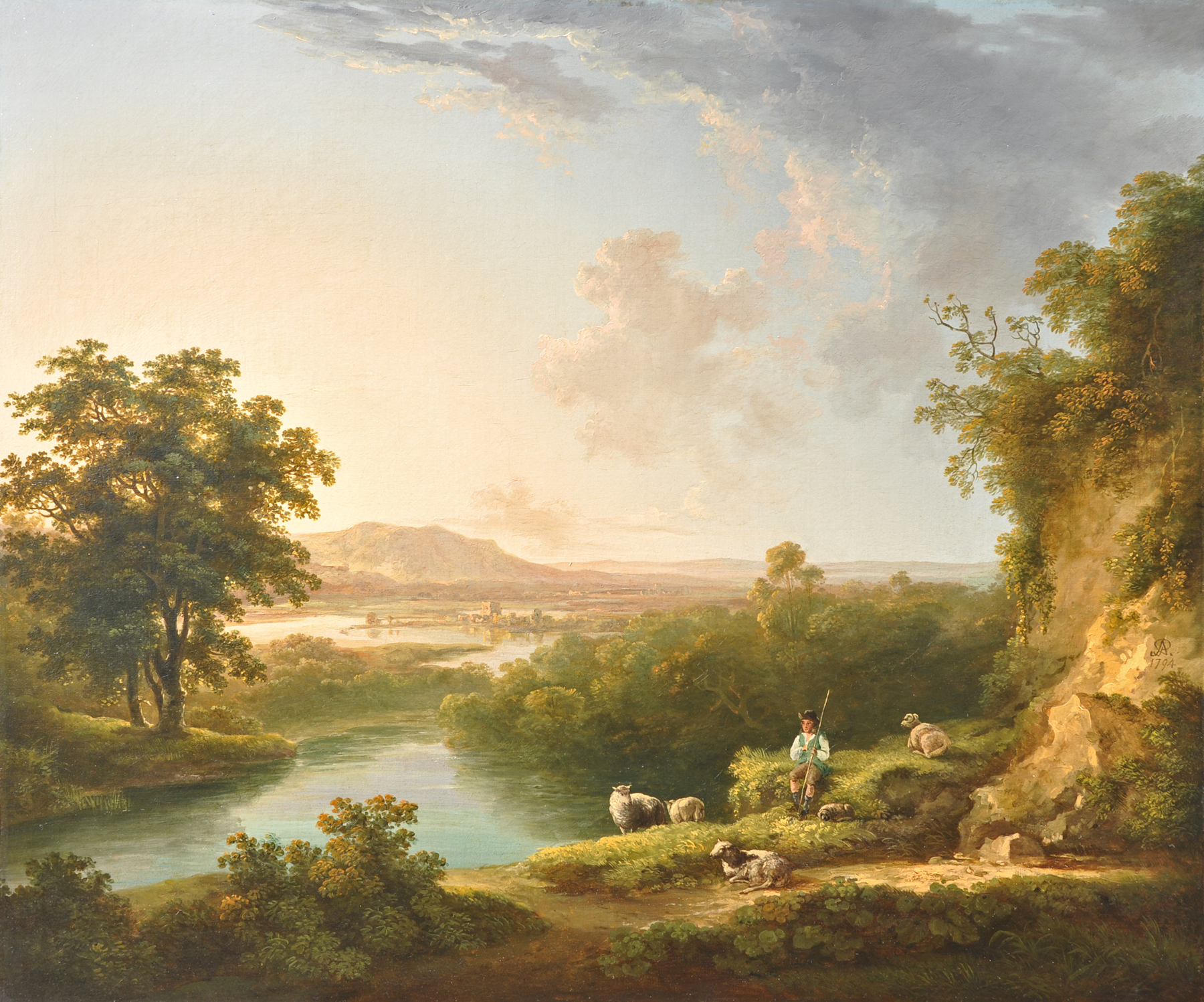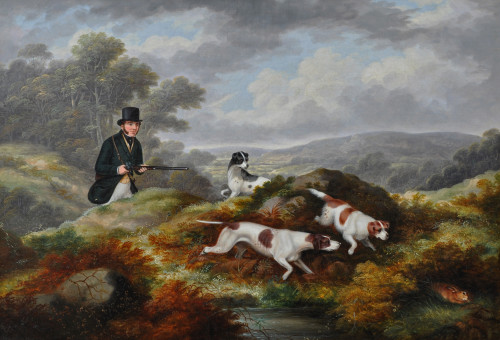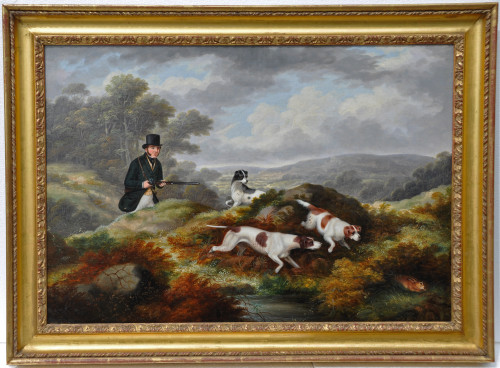An extensive Evening Landscape with a Drover and Cattle by a Pool in the Foreground
An extensive Evening Landscape with a Drover and Cattle by a Pool in the Foreground
ABRAHAM PETHER
English School
1756-1812
An extensive Evening Landscape with a Drover and Cattle by a Pool in the Foreground
Oil on canvas, signed with monogram and dated 1794
63.5 x 74.7 cms
25 x 293/8 inches
Overall framed size 80.2 x 92.3 cms
315/8 x 363/8 ins
One of a family of five painters, Abraham was born in Chichester in 1756, and was a cousin of the renowned engraver and miniaturist, William Pether (1731-c.1795).
Abraham showed great talent as a musician in childhood and played the organ in a Chichester church at the age of nine. However, he resolved to become an artist and was a pupil of George Smith, one of the three Smith brothers from Chichester who were notable local landscape painters. The association had begun when William Pether made a fine mezzotint of the Smith brothers which was published in 1765. Abraham initially painted in his tutor’s style but then enlarged on it by incorporating some elements of Richard Wilson as well as displaying a knowledge and influence of the 17th Dutch masters such as A van Everdingen. He moved to London and began an industrious and fruitful career showing at the annual exhibitions in the capital.
He was particularly adept at capturing the feel of the light and atmosphere of the environs that he was depicting and imbuing a sense of an English arcadia. From about 1784, he specialised a good deal in moonlit scenes which earned him the sobriquet “Moonlight Pether”. His night-time Eruption of Vesuvius; Fire at Drury Lane, An iron foundry by moonlight; The Thames and Greenwich Hospital by moonlight and Fire by Moonlight were favourable comparisons to similar works by Joseph Wright of Derby who was regarded as the finest exponent of this genre. Pether painted other Italian views as well as his more common English scenes which were taken from such diverse areas as Hampshire, Sussex, Essex, Cumberland, Warwickshire and London.
He was also a busy and clever inventor, building his own microscopes and telescopes as well as devising a new type of pencil. He gave lectures on electricity utilising instruments which he had constructed, but this alternative career, although much talked about, was usually done so in a derisory manner. It is as a painter that he is regarded today but his scientific knowledge and curiosity is still evident in some of his paintings, particularly in his moonlit landscapes, where the astronomical conditions are properly rendered in paint, a good example being Harvest moon which was an exhibit at the Royal Academy in 1795.
Pether exhibited 61 works at the Royal Academy, 24 at the Society of Artists, 39 at the Free Society and one at the British Institute. Exhibited titles include A View in Kensington Gardens; Small landscape and cattle; Evening – with a cornfield from nature; Mount Vesuvius; Morning, with a view of Kirkstall Abbey in Yorkshire; Effect of the sun just before a shower and Rest on the flight into Egypt.
Despite the popularity of his work, the demands of supporting his family of nine children was a severe burden and he was always struggling financially. He contracted a disease which became chronic and is believed to have been caused by lead poisoning and a consequence of his scientific experimentation. This affected his ability to work, exacerbating his precarious financial situation and within three years all of his savings had dissipated. He died in Southampton, aged just 56, on 13th April 1812. His wife Elizabeth and their children were left destitute and although they had a good case to receive assistance from the Artists’ Benevolent Fund – which had been set up in 1810 to support artists in dire straits - , none was forthcoming, occasioning a vitriolic attack on those who ran the charity.
Elizabeth Pether later formed a business partnership with a Thomas Thornton establishing “Pether & Co.” which made chalk and black lead pencils. In 1816, an advertisement appeared in The Times with the claim of the instruments that: “the leads being freed by a chymical process from all impurities, and scratching particles”.
There is an early record of a Thomas Pether residing in the same premises as Abraham and it is believed that this is a brother who exhibited wax portraits at the Free Society between 1772 and 1781 with titles such as A portrait of a gentleman, in wax; Birds and A bust of his Majesty, in composition.
Two of his sons became painters: Abraham Jnr and Sebastian with Abraham most closely resembling his father’s style and subject matter. Sebastian had a son Henry (op.1828-65) who took his grandfather’s predilection for moonlight scenes to almost an addictive level but he falls short in composition in comparison to his forbear and the technique is slicker and without the instinctive warmth and atmospheric insight.
Abraham collaborated with Philip Reinagle on the latter’s The Night blowing Cereus with the flower painted by Reinagle and the moonlit background provided by Pether and this was engraved by Robert Dunkarton as part of the series Temple of Flora. The British Museum has one of the prints in its collection. It also holds further prints in the series: Persian Cyclamen engraved by William Elmes and the Snowdrop engraved by William Ward with a further example in the Victoria and Albert Museum’s collection. The BM also has Cheapside as it appeared before the Fire of London engraved by Robert Jacob Hamerton. Another of Abraham Pether’s paintings that was turned into a print was Warwick Castle which W Birch reproduced in his volume Delices in 1789.
Some of his paintings can be seen in the collections of the following museums and institutions: British Museum (pencil drawing of a moonlit landscape); National Maritime Museum; Government Art Collection; Guildhall Art Gallery; Dulwich Picture Gallery; Ferens Art Gallery; Manchester Art Gallery; Brighton and Hove Museum; York Art Gallery; Derby Museum; Bolton Museum; Shipley Art Gallery; Preston Park Museum; The Council House, Chichester; Essex Record Office, Chelmsford; Hampshire Cultural Trust; Temple Newsham House, Leeds; Bolton Museum; National Trust – Nostell Priory and Chastleton House; Yale Center for British Art.
Bibliography: Dictionary of British Landscape Painters - M H Grant
The Dictionary of British 18th Century Painters, Ellis Waterhouse
Dictionnaire des Peintres – E Benezit
Dimensions:
RELATED ITEMS
























